ASUS Maximus VI Impact Review: ROG and Mini-ITX
by Ian Cutress on November 22, 2013 10:00 AM ESTComputational Benchmarks
Readers of our motherboard review section will have noted the trend in modern motherboards to implement a form of MultiCore Enhancement / Acceleration / Turbo (read our report here) on their motherboards. This does several things – better benchmark results at stock settings (not entirely needed if overclocking is an end-user goal), at the expense of heat and temperature, but also gives in essence an automatic overclock which may be against what the user wants. Our testing methodology is ‘out-of-the-box’, with the latest public BIOS installed and XMP enabled, and thus subject to the whims of this feature. It is ultimately up to the motherboard manufacturer to take this risk – and manufacturers taking risks in the setup is something they do on every product (think C-state settings, USB priority, DPC Latency / monitoring priority, memory subtimings at JEDEC). Processor speed change is part of that risk which is clearly visible, and ultimately if no overclocking is planned, some motherboards will affect how fast that shiny new processor goes and can be an important factor in the purchase.
For reference, the Maximus VI Impact in this review did enable MCT during the benchmarks.
Point Calculations - 3D Movement Algorithm Test
The algorithms in 3DPM employ both uniform random number generation or normal distribution random number generation, and vary in various amounts of trigonometric operations, conditional statements, generation and rejection, fused operations, etc. The benchmark runs through six algorithms for a specified number of particles and steps, and calculates the speed of each algorithm, then sums them all for a final score. This is an example of a real world situation that a computational scientist may find themselves in, rather than a pure synthetic benchmark. The benchmark is also parallel between particles simulated, and we test the single thread performance as well as the multi-threaded performance.
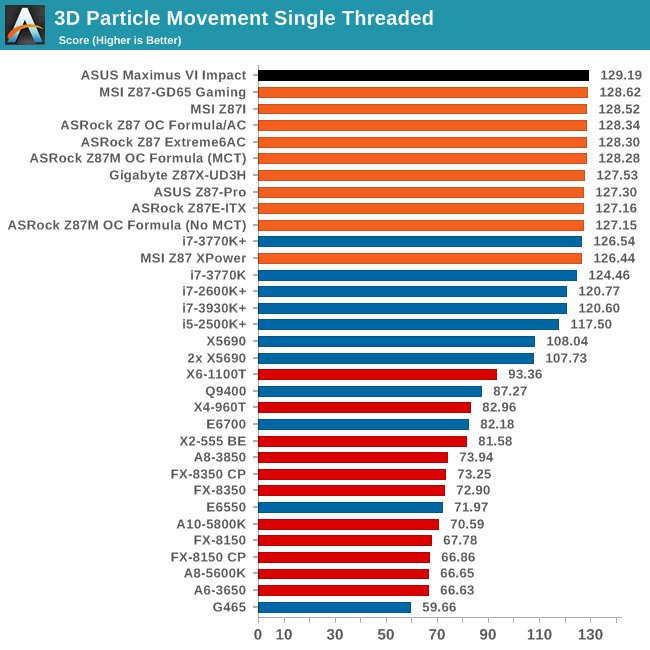
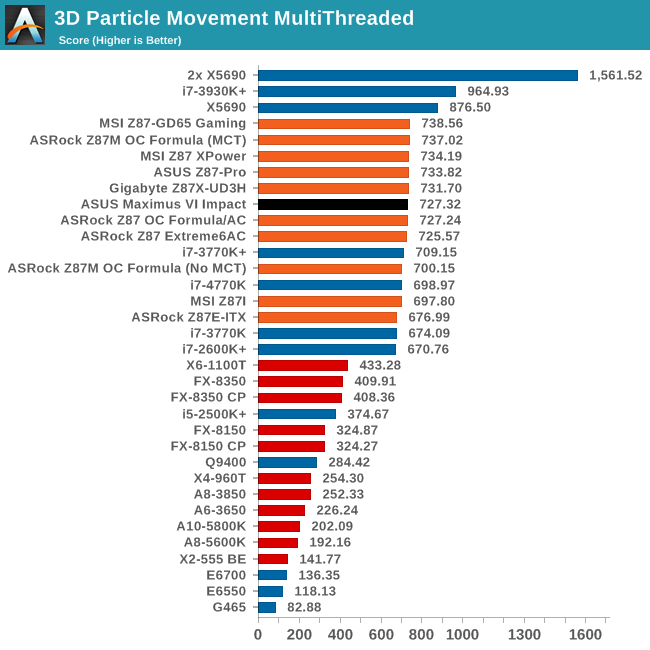
For single threaded optimization of FP calculations, the M6I seems to be right on the money. Multithreaded seems to be middle of the field in 3DPM.
Compression - WinRAR 4.2
With 64-bit WinRAR, we compress the set of files used in the USB speed tests. WinRAR x64 3.93 attempts to use multithreading when possible, and provides as a good test for when a system has variable threaded load. WinRAR 4.2 does this a lot better! If a system has multiple speeds to invoke at different loading, the switching between those speeds will determine how well the system will do.

WinRAR also comes across midfield, with similar times to the Z87 Pro.
Image Manipulation - FastStone Image Viewer 4.2
FastStone Image Viewer is a free piece of software I have been using for quite a few years now. It allows quick viewing of flat images, as well as resizing, changing color depth, adding simple text or simple filters. It also has a bulk image conversion tool, which we use here. The software currently operates only in single-thread mode, which should change in later versions of the software. For this test, we convert a series of 170 files, of various resolutions, dimensions and types (of a total size of 163MB), all to the .gif format of 640x480 dimensions.
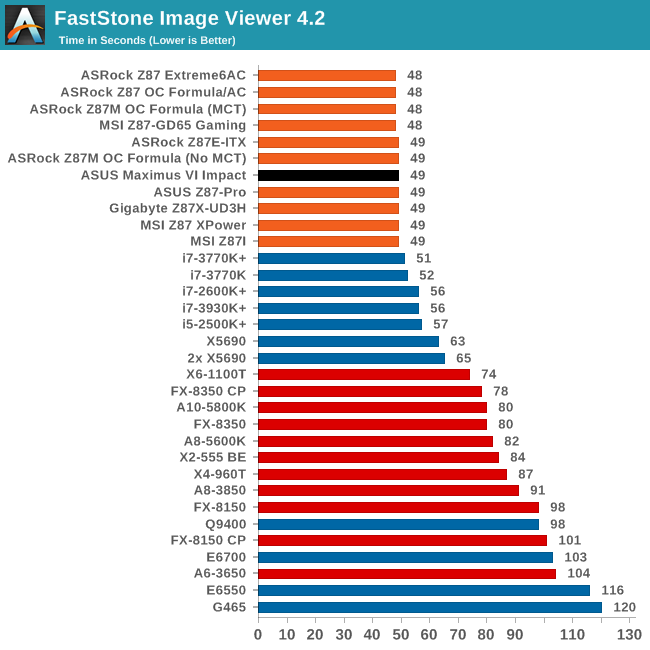
Every Z87 motherboard seems to score either 48 or 49 seconds in FastStone, and the M6I is no different.
Video Conversion - Xilisoft Video Converter 7
With XVC, users can convert any type of normal video to any compatible format for smartphones, tablets and other devices. By default, it uses all available threads on the system, and in the presence of appropriate graphics cards, can utilize CUDA for NVIDIA GPUs as well as AMD WinAPP for AMD GPUs. For this test, we use a set of 33 HD videos, each lasting 30 seconds, and convert them from 1080p to an iPod H.264 video format using just the CPU. The time taken to convert these videos gives us our result.
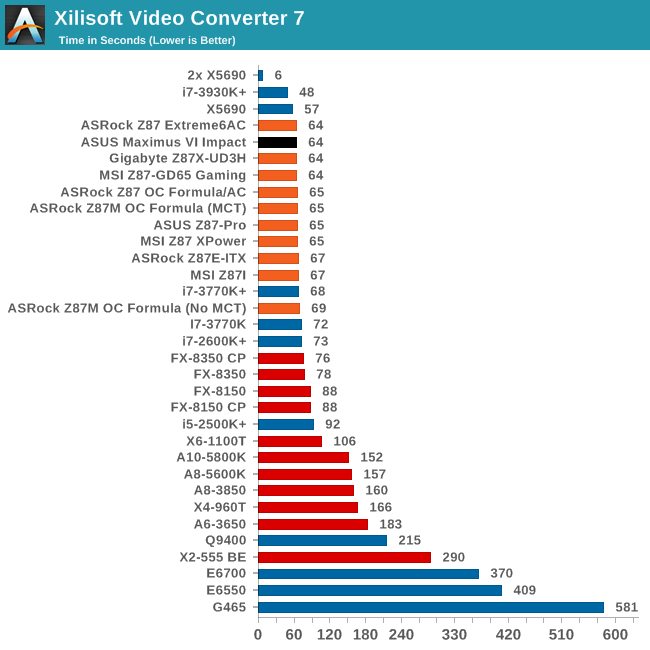
ASUS is in the leading pack around 64 seconds for XVC.
Video Conversion - x264 HD Benchmark
The x264 HD Benchmark uses a common HD encoding tool to process an HD MPEG2 source at 1280x720 at 3963 Kbps. This test represents a standardized result which can be compared across other reviews, and is dependent on both CPU power and memory speed. The benchmark performs a 2-pass encode, and the results shown are the average of each pass performed four times.
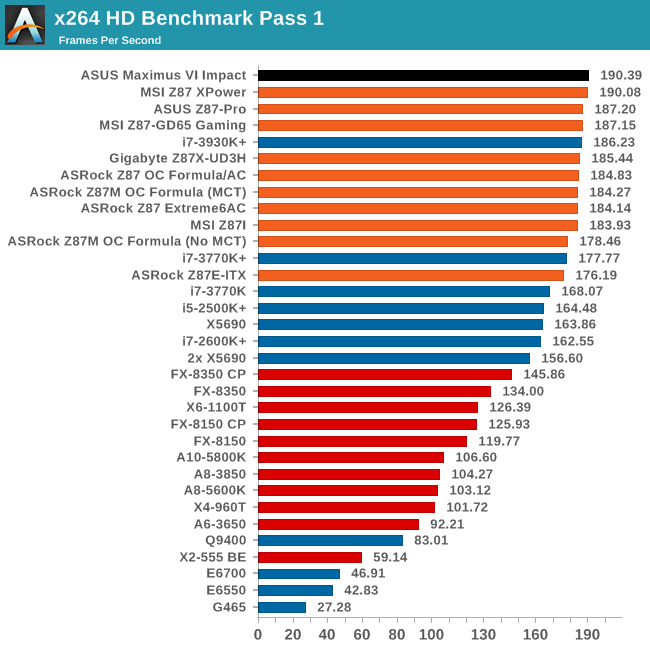
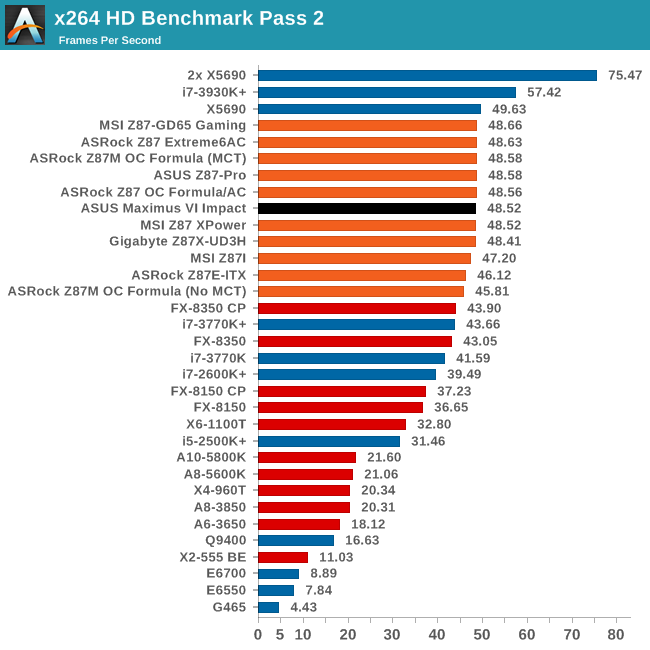
There still seems to be some room at the top in the first pass, with the M6I taking the crown. The second pass seems to have hit an asymptotic limit around 48.6 FPS for the 4770K.
Grid Solvers - Explicit Finite Difference
For any grid of regular nodes, the simplest way to calculate the next time step is to use the values of those around it. This makes for easy mathematics and parallel simulation, as each node calculated is only dependent on the previous time step, not the nodes around it on the current calculated time step. By choosing a regular grid, we reduce the levels of memory access required for irregular grids. We test both 2D and 3D explicit finite difference simulations with 2n nodes in each dimension, using OpenMP as the threading operator in single precision. The grid is isotropic and the boundary conditions are sinks. Values are floating point, with memory cache sizes and speeds playing a part in the overall score.
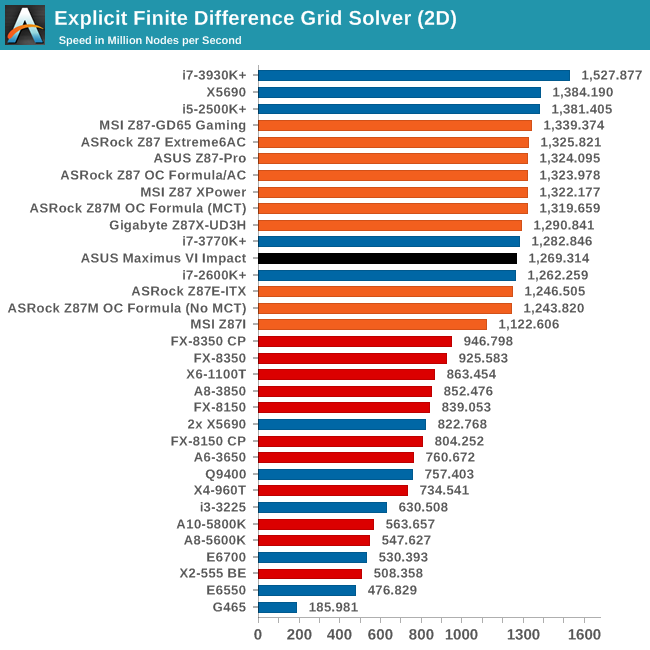

The M6I seems to hit a rough patch with our Ex-FD simulations, 2D being particularly affected.
Grid Solvers - Implicit Finite Difference + Alternating Direction Implicit Method
The implicit method takes a different approach to the explicit method – instead of considering one unknown in the new time step to be calculated from known elements in the previous time step, we consider that an old point can influence several new points by way of simultaneous equations. This adds to the complexity of the simulation – the grid of nodes is solved as a series of rows and columns rather than points, reducing the parallel nature of the simulation by a dimension and drastically increasing the memory requirements of each thread. The upside, as noted above, is the less stringent stability rules related to time steps and grid spacing. For this we simulate a 2D grid of 2n nodes in each dimension, using OpenMP in single precision. Again our grid is isotropic with the boundaries acting as sinks. Values are floating point, with memory cache sizes and speeds playing a part in the overall score.
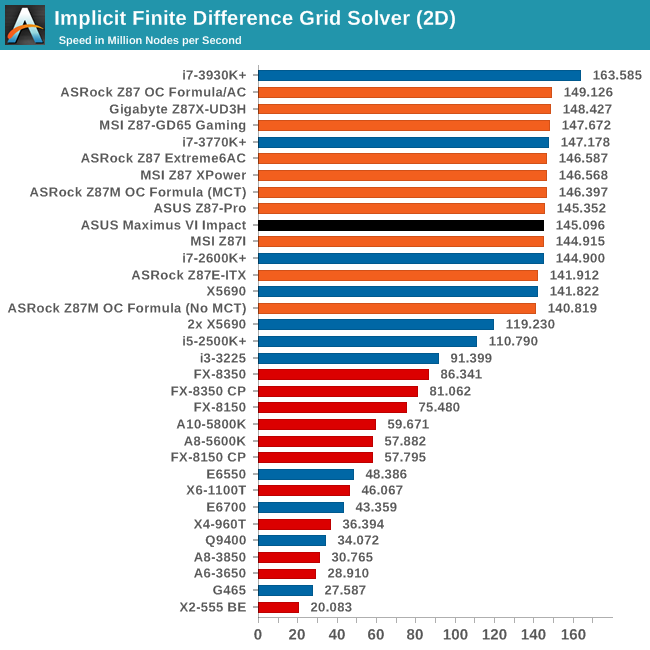
Point Calculations - n-Body Simulation
When a series of heavy mass elements are in space, they interact with each other through the force of gravity. Thus when a star cluster forms, the interaction of every large mass with every other large mass defines the speed at which these elements approach each other. When dealing with millions and billions of stars on such a large scale, the movement of each of these stars can be simulated through the physical theorems that describe the interactions. The benchmark detects whether the processor is SSE2 or SSE4 capable, and implements the relative code. We run a simulation of 10240 particles of equal mass - the output for this code is in terms of GFLOPs, and the result recorded was the peak GFLOPs value.
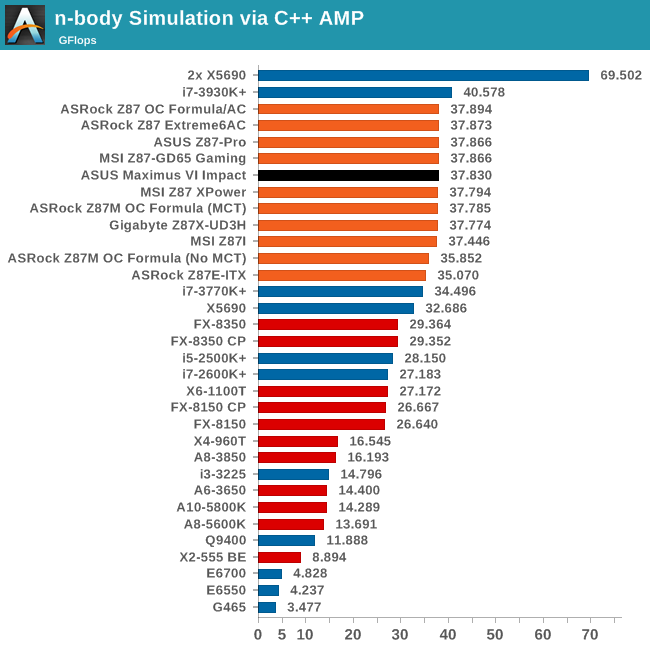










69 Comments
View All Comments
coolhund - Saturday, December 7, 2013 - link
First things first. If you want quality youre at the wrong place with Asus anyway. Their mainboards die like flies.dcoca - Friday, January 9, 2015 - link
Who else would you pick? MSI (no thanks), Asrock ( lower tier Asus) , gigabyte ( I'll pass) ; I would agree on Asus video cards and their crappy coil whine issue.. but their motherboards are greatdcoca - Friday, January 9, 2015 - link
I think this board is great: it has the features that I need, it doesn't need to fit eveyone's bill.Morawka - Saturday, November 23, 2013 - link
Asus RAM Disk is awesome. Think Apple's Fusion Drive with 10X the performance.I always load whatever game i'm playing into the RAM DISK and keep it there until i beat the game or get bored with it. And then it goes back to the HDD for archive.
The best part is, RAM Disk will work on older boards, even x58 boards. I'm not sure if it's locked to Asus, but i was using it on my Rampage II Extreme about 4 months ago, and it worked like a charm.
Morawka - Saturday, November 23, 2013 - link
The only game i've not been able to fit on my RAM DISK is Battlefield 3 and 4. They simply are to big. I have 32GB of RAM.Gigaplex - Monday, November 25, 2013 - link
A RAM disk is not an exclusive feature of Asus. They've been around for decades.Rajinder Gill - Thursday, November 28, 2013 - link
You are correct, RAM disks have been around for ages. However, the functionality of the ASUS package is not available on any of the free offerings one finds on the web. The junction feature of the ASUS package is found on some of the commercially available packages which cost $30 to buy.Hairs_ - Saturday, November 23, 2013 - link
The market for Liquid-Nitrogen compatible >$200 Mini ITX boards is, I've heard, absolutely HUGE. Literally thousands of people waiting with baited breath on this review.Just as well the vast majority of people aren't interested in ~$100-$130 boards, because the lack of relevant reviews would really make them wonder whether tech sites are more interested in serving what the manufacturers' PR want than what buyers need.
ShieTar - Tuesday, November 26, 2013 - link
Oh, come on. AT review what they get. They don't have the budget to go and buy any damn Board they want to look at, and the low-margin board builders won't afford sending out hundreds of review samples. And for those products, AT is probably not the priority number 1. There are still lots of paper-magazines out there doing nothing but comparisons of "normal stuff", being read by people who want to have a quick help for their buying decision. These magazines are the best place to get your 80$-Mainboard reviewed in.aatroxed - Monday, November 25, 2013 - link
How would the onboard sound compare to a dedicated sound card? I'm still rocking an older creative xtreme music - would this more than match sound quality?